Sweet pepper leaves are all in holes: who eats the crop and how to deal with pests
The appearance of holes in bell peppers grown in a greenhouse or open field indicates pests. Some of them are capable of ruining the harvest in a short time. Thanks to the timely identification of the problem and the use of effective methods of dealing with the enemies of vegetable crops, dangerous consequences can be avoided. How exactly - we'll talk in the article.
The content of the article
Holes appeared on the pepper leaves
If bell pepper leaves are all in holes, who eats it? Perforated leaves and fruits - evidence that the vegetable crop was attacked pests... If caterpillars and signs of plant damage are found, urgent action should be taken. In advanced cases, it will be difficult to deal with the problem.
Knowing the main signs inherent in certain types of pests will help to find out who eats bell peppers in the beds.
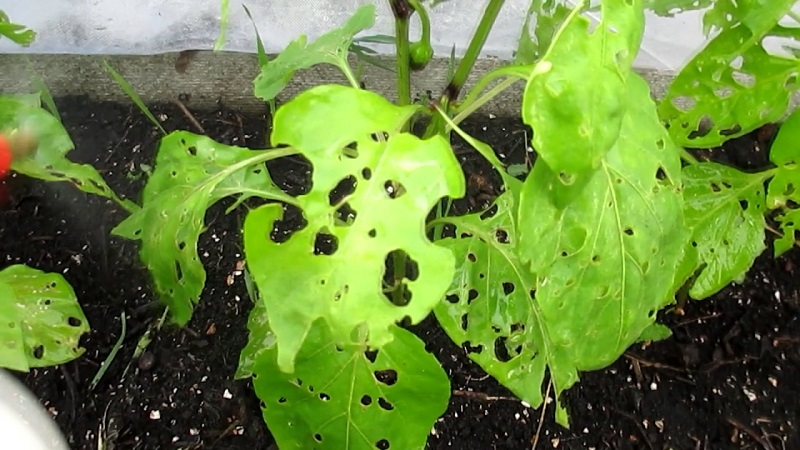
Slugs
Enemy of sweet pepper plantings - slug... it land mollusk, visually resembling a snail without a shell... There are many teeth (chitin) in the mouth of the pest, which it uses to grind food.
A plant damaged by a land mollusk determined by the presence of smooth round holes on the leaves and a chewed edge. Slugs it is also common to damage the fruit: characteristic marks will be visible on them. Another sign of slug damage is white streaks on the leaves of pepper. They are formed by dried mucus left by the mollusk when moving.
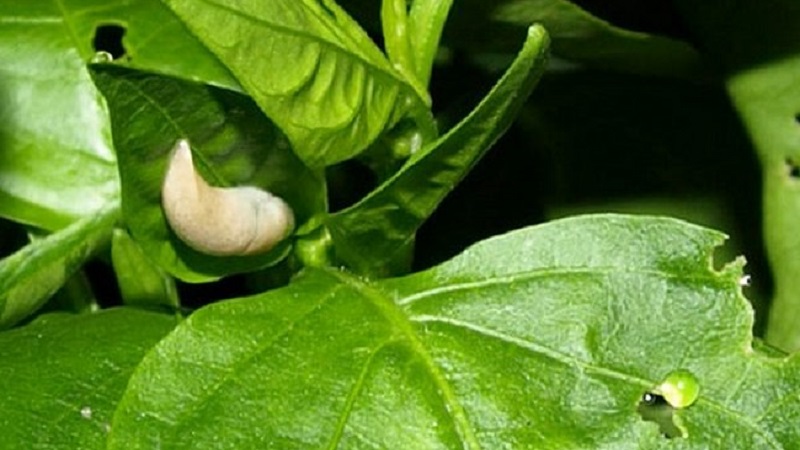
Slugs prefer a nocturnal lifestyle... During the day they hide, buried in the ground by 3 cm. They also lay eggs there.
Reference. In the absence of conditions for reproduction, this enemy of sweet pepper will die. Slugs feel good at temperatures up to + 25 ° C. They like moist soil and thickened plantings.
Aphid
A common pest that infects bell peppers in the beds is aphid. Plantings in open and closed ground suffer from it.
Peppers are susceptible to black and green aphids... The pest settles on the inside of the leaf. He eats fruits, leaves, plant stems.
The presence of aphids is indicated by a number of signs:
- deformed and withered leaf plates;
- dry areas of a round shape and the presence of holes on sheets, fruits;
- sticky sweetish bloom on the leaf plate;
- black grains are sooty fungus.
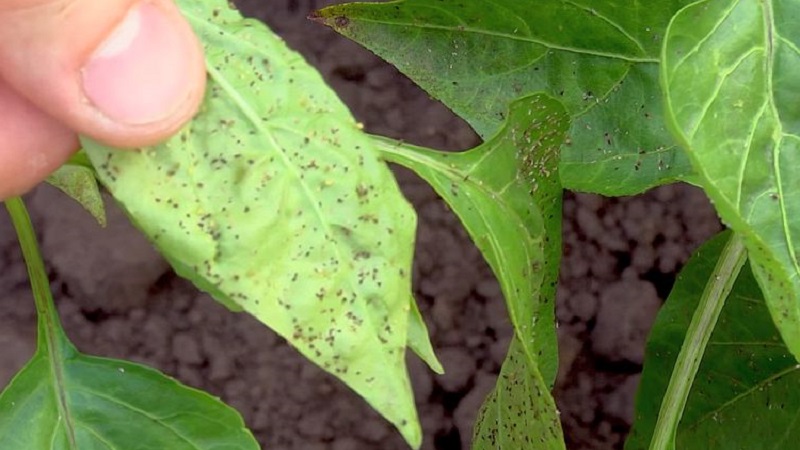
Aphid affects bell peppers due to improperly prepared soil in autumn or spring... The eggs of the pest hibernate under a layer of fallen leaves, and with the onset of spring heat, females appear en masse, laying clutches on plants. The peak of aphid attacks on sweet pepper planting occurs in the first month of summer.
Colorado beetles
Among the enemies of the bell pepper, the larvae of the Colorado potato beetle are distinguished. Large numbers of orange eggs appear on the leaves on both sidesthat are laid by adults.
Important! They are struggling with the problem using special purchased products. But the pest is able to adapt to chemicals, become insensitive to their action, which complicates the fight against it.
If holes appear in the central part of the sheet plate - means that the larvae eat pepper. Then the edges of the sheets are eaten. If you do not take action, the pest will leave bare petioles.

Caterpillars
More than a hundred varieties of scoops are capable of damaging the plantings of sweet pepper.The enemy enters the garden in the form of an inconspicuous brownish or gray butterfly, on the wings of which there are kidney-shaped orange specks.
Caterpillar green scoops with a light green stripe on the side and transverse lines on the back. It appears on the surface only at night.
The scoop eats vegetables in the same way as other types of caterpillars.... It gnaws at the edges of the leaf plate and can damage the fruit. The pest is most active in the summer months.

Greenhouse pests
When growing sweet peppers in the greenhouse his main enemy is aphid... The defeat of aphids is observed against the background of overfeeding of plants with nitrogen fertilizers.
Besides aphids, vegetables in greenhouse conditions are eaten by other pests... Among them:
- Whitefly. The insect settles on the lower leaves. It resembles a small moth. Traces of presence are similar to the work of aphids. By its activity, the whitefly harms fruit ripening.
- Medvedka. The insect is large in size, brown in color with short elytra and digging legs. Medvedka digs holes in the ground, feeds on the roots and stems of sweet pepper.
- Gall nematode. The parasite infects the root system of the plant, leading to its death.
- Tobacco thrips. The pest is visible by the spots of yellow or grayish color that have appeared on the leaf plates. The parasite is eliminated by spraying plants with special biological or chemical preparations.
For open ground
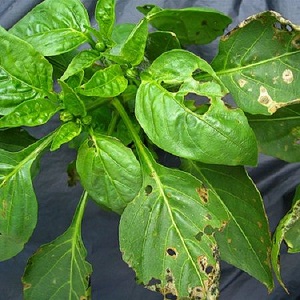 Colorado beetles are more likely to threaten plantings of sweet peppers growing in open ground conditions than greenhouse ones. They are also susceptible to attacks from outside:
Colorado beetles are more likely to threaten plantings of sweet peppers growing in open ground conditions than greenhouse ones. They are also susceptible to attacks from outside:
- Spider mite... The small translucent parasite is difficult to see with the naked eye. Its presence is visible by yellow dots on the plant (leaves, stems, flowers). The presence of a pest is also evidenced by the appearance of a cobweb under the leaves. The affected plant may die.
- Muravyov. They are attracted to bushes affected by aphids. The appearance of an ant colony of thousands is visible to the naked eye. The stems are tightly covered with insects.
- Sprout fly. An adult gray insect with brown stripes on the front side of the body eats up vegetable sprouts, and its larvae harm germinating seeds.
What to do, how to process
The use of chemicals and folk methods, the duration of the treatment of sweet pepper bushes is selected based on:
- pest varieties;
- the number of insects;
- stages of plant damage.
Ready-made chemicals
Use ready-made commercial insect preparations, following the instructions. Of the ready-made chemicals,:
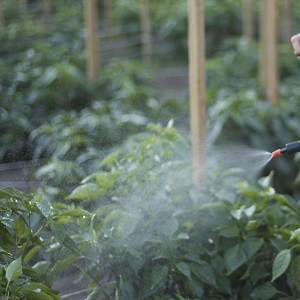 from slugs - drugs "Predator", "Ferramol", "Thunderstorm", "Slime-eater";
from slugs - drugs "Predator", "Ferramol", "Thunderstorm", "Slime-eater";- against aphids - "Fitoverm", "Agravertin", "Keltan", "Karbofos";
- against the Colorado potato beetle - "Karate", "Decis", "Colorado";
- from the scoop - "Arrivo", "Sherpa", "Zolon", "Volaton";
- from whitefly - "Confidor" or "Mospilan" (used once a season), "Verticillin" (twice with an interval of 7-10 days);
- against the bear - "Thunder", "Medvetoks", "Grizzly", "Bankol", "Fenaxin Plus" (brought into the ground 3-5 cm deep);
- from sprout flies for crops grown in open ground - "Karbofos", "Fufanon" (spraying is carried out during the growing season);
- against root gall nematode - systemic drugs "Marshal", "Aldoxycarb", "Carbofuran";
- from spider mites - means "Aldikarb" (the granules are introduced into the soil), "Antiklesh", "Fitoverm" (pepper bushes are sprayed);
- from ants - "Muratsid", "Muravyin", "Thunder-2" and others;
- against thrips - Fitoverm, Vertimek, Confidor.
Traditional methods
There is an alternative to chemicals for pest control - folk recipes and mechanical impact on crops. These methods are safe and affordable for gardeners.
To get rid of slugs, you need:
- Tidy up the garden - remove weeds and get rid of plant residues.
- Dig grooves between the rows of sweet pepper bushes, pour lime, ash, ground black pepper or tobacco dust into them. Slugs will not crawl through such an obstacle.
- Cover the plant with plastic wrap. The pest, crawling under it at night, dies from the heat of the day.
- Sprinkle lime over soil after heavy rain or good watering.
Fight aphids on pepper leaves you can use self-prepared formulations:
- Soapy tincture of ash. You will need one glass of raw materials per bucket of water. The mixture is insisted for a day. The solution is enriched with a glass of liquid soap. After the extermination of aphids, the culture is sprayed with water.
- Wormwood infusion. Wormwood is soaked in water. The solution is insisted for a day, then the plant is treated with it.
- Onion peel solution. For a liter jar of boiling water, take 1 glass of dry raw materials. The solution is kept for ½ day.
- Coniferous solution. Needles are poured into a container by 1/3, filled to the brim with liquid. The mixture is boiled for 60 minutes, insisted for a day.

Such measures are applicable against the Colorado potato beetle:
- systematic collection of larvae and beetles from bushes;
- garlic or calendula are planted near the beds with pepper - the smell of these plants scares off the pest;
- prepare a solution from a glass of ash, wormwood (50-200 g), boiling water (10 l). The mixture is infused for three hours, filtered, the beds are sprayed on it.
To combat the scoop, traps are made from cut plastic bottles... They are placed one meter above the ground. Fermented jam or juice is used as bait. Caterpillars are also harvested by hand at night.
Whiteflies get rid of like this:
- Wash off adult insects and their larvae with a water jet, then the leaves are treated with soapy water.
- Use yellow and bright blue traps. They are made with their own hands, applying a sticky composition to the bright plywood.
- By the biological method. Ladybugs are launched into a greenhouse or an infusion of herbs is prepared. The garlic head is crushed and filled with water (500 ml). Infused liquid for 7 days. Before use, dilute in a proportion of 5 g per 1 liter of water and spray pepper bushes.
They get rid of the bear with a light trap... It is constructed from a lamp and a vessel containing a water-kerosene mixture. In the fight against the parasite, they are looking for its oviposition and larvae. This is done from late May to early summer. They regularly loosen the ground, treat the detected pest moves with soapy water.
Against the sprout fly special glue traps are effective.
Gall nematode is exterminated like this:
- scalding the soil with boiling water 40-50 cm deep. Then the beds are covered with foil for 4 hours;
- by cleaning the roots of peppers from the soil. They are immersed in water at a temperature of + 50-60 ° C. The worms die within five minutes. To destroy the eggs of the pest, you should hold the roots of the bush in hot water for 30 minutes.
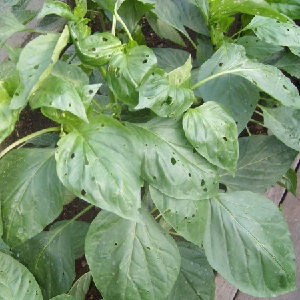 For spider mites, an effective remedy for the preparation of which kerosene (2 g) is poured into warm water (10 l) and soap shavings (40 g) are added... The solution is watered with the plants affected by the pest.
For spider mites, an effective remedy for the preparation of which kerosene (2 g) is poured into warm water (10 l) and soap shavings (40 g) are added... The solution is watered with the plants affected by the pest.
Helps get rid of ticks and tobacco infusion... For its preparation, 400 g of tobacco leaves are brewed with boiling water (10 l). Insist for several hours, bring to a boil again. The broth is diluted with water (10 l) and laundry soap (40 g) is added. The tool is used to process sheet plates.
You can eliminate an ant colony by killing its uterus and destroying the anthill... It should be scalded with boiling water or covered with a thick layer of hot ash.
There is another way to fight ants.... A jar filled with honey solution or sweet water is left next to the ant trail. An ant caught in a trap cannot get out of it.
Get rid of thrips like this:
- washing off the pest with a water jet;
- using a yellow or blue sticky trap;
- spraying the peppers with marigold broth infused for several days;
- garlic water made from water (250 ml) and chopped garlic head into gruel.
Preventive measures
Prevent the appearance of perforated leaves when growing sweet peppers, preventive measures will help:
- regular loosening of the soil;
- spraying plants with garlic or soapy water, ash infusion;
- weeding;
- autumn disinfection of soil and greenhouses.
Conclusion
Many pests that eat leaves, stems and fruits threaten the planting of sweet peppers. Insecticides will help to effectively fight them. Compliance with the technology of growing peppers with preventive measures will protect the vegetable crop from attacks of parasites and will allow to harvest a rich harvest.